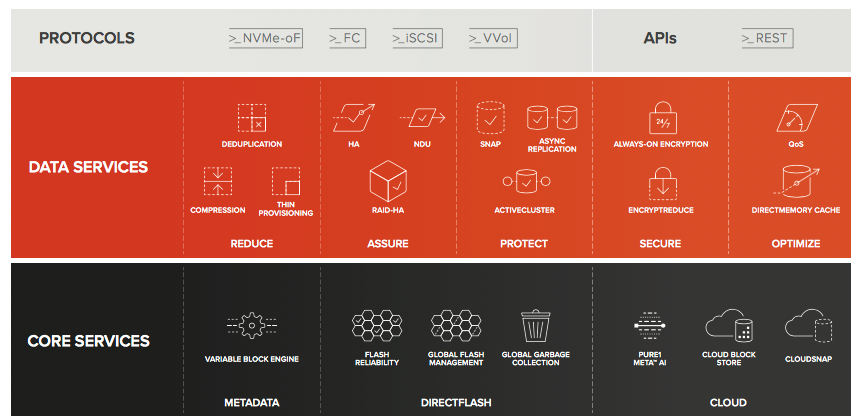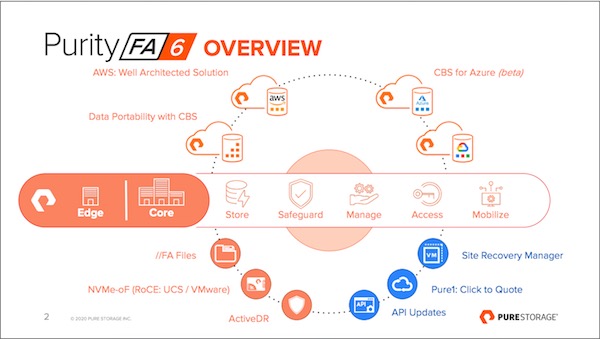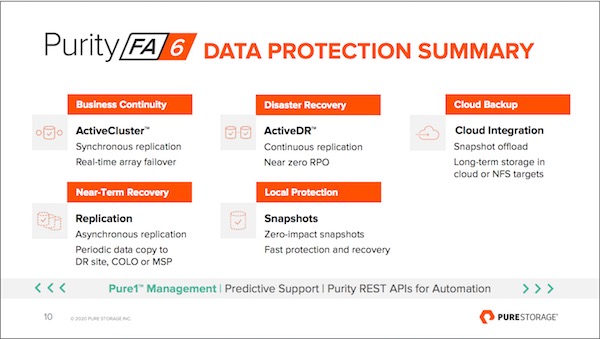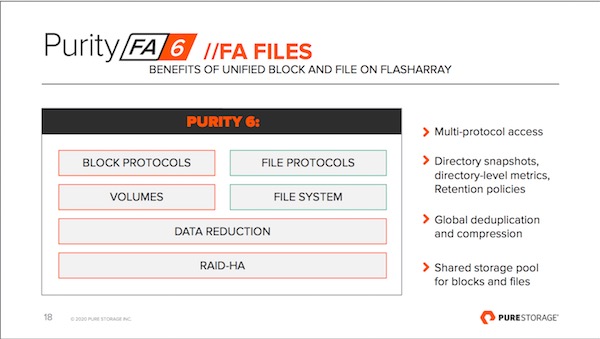Pure Storage Purity 6.0 for FlashArray
With active disaster recovery built on continuous replication and unified block and file capabilities
This is a Press Release edited by StorageNewsletter.com on June 15, 2020 at 2:20 pmPure Storage, Inc. announced Purity 6.0 for FlashArray, the latest version of its suite of software.
Engineered with the modern organization in mind, these new agile data services provide customers with an efficient way to store, safeguard, manage, access and mobilize their data with strategic consumption models custom-tailored to their needs.

Purity 6.0 further simplifies infrastructure with a unified block-and-file solution designed to help solve infrastructure challenges, including storage silos and sprawl, which impact modern business across every industry. With a host of new agile data services, customers can leverage 2 key new capabilities – unified protocol support with NFS and SMB, along with active disaster recovery built on brand new continuous replication technology. As part of the Evergreen Storage subscription model, these new features require no additional licenses, no added support costs, and zero added complexity.
“Flexible consumption models represent the bedrock of Pure’s modern data experience,” said Prakash Darji, GM, FlashArray. “We’ve had the tremendous advantage of being purpose-built for the modern era — our solutions are designed for massive amounts of data, to be fundamentally upgradeable without disruption, and to be compatible with future innovation so that our customers never have to wait for the latest tools. Purity 6.0 represents the next and most logical step in delivering that continued value to our customers — services that can be consumed in whatever way best fits the customer need at any given moment.”
Pure’s new unified block and file capabilities on FlashArray save customers the trouble and expense of running 2 incompatible environments. They are designed to simplify operations for organizations that primarily run block storage but still require or utilize separate NAS. This enables customers to run all workloads within the Purity operating environment, leverage the same data layer, user-interface, pool of capacity, and benefit from Pure’s global data reduction.
Similarly, the new continuous replication feature, ActiveDR, helps customers improve their business resiliency without the cost and complexity of third-party disaster recovery software add-ons. This new active-passive replication technology addresses a major business requirement by protecting critical applications with a near-zero RPO. Now customers have the ability to leverage synchronous, active-active, replication with ActiveCluster, snapshot-based asynchronous replication, and now continuous replication all on the same Purity platform.
“Pure Storage enables us to offer entirely new areas of service for our faculty, staff and students by continuously innovating with our modern set of IT problems in mind,” said James Kelly, senior systems administrator for research support, Chapman University. “The challenges we face are diverse, and require a diverse set of solutions. Purity 6.0 will allow us to solve critical problems in more – and more creative – ways. The unified SAN and NAS capabilities of this new FlashArray OS represent a game-changer for our highest-performance file-based workloads that otherwise need to run in all-block environments. It offers us a great way to cost-effectively run VDI or performance-critical file-based applications right alongside our key enterprise and research workloads in Pure’s familiar, reliable, cloud-like operating environment.”
Enterprises with big data or machine learning requirements will still assign those workloads to FlashBlade, but for other use cases and for many smaller businesses FlashArray now addresses all data storage needs.
“Managing each file server and its data in a consistent way can be cumbersome without shared storage between them. Compromising on performance or making similar infrastructure tradeoffs is not an option for modern organizations,” said Jeff Fonke, global technical solutions architect, WWT. “We worked with Pure to beta test the file implementation in the WWT Advanced Technology Center, where we rely on a wealth of resources for testing OEM integration for new features. FlashArray affords our joint customers an uncompromising converged block and file solution capable of handling critical workloads and daily-use unstructured data.”
Purity 6.0 delivers additional enhancements, capabilities and solutions that customers can adopt immediately, non-disruptively, and as part of their Evergreen subscription to innovation.
Highlights from this release include:
- Expanded backup to cloud options with CloudSnap for Google Cloud Platform: A technical preview, this capability adds cloud storage targets on the Google Cloud Platform where Pure ‘s space-efficient snapshots can be replicated for offsite storage and reuse.
- Categorize data sets for easier identification with public volume tags
- Ensure data is safeguarded and access is controlled using RSA’s two-factor and multi-factor authentication
- Effectively plan for capacity expansion with Pure1 click-to-quote
- Protect critical workloads using ActiveDR with the following validated designs:
– Virtualized workloads using ActiveDR support for VMware Site Recovery Manager
– Business critical applications such as: Microsoft SQL, Oracle, SAP, and MongoDB - Protect unstructured data on Purity’s new file services with Veeam and CommVault backup solutions
“For Pure Storage, the introduction of native file system support on its FlashArray will be a boon for existing and new customers alike,” said Eric Burgener, research vice president, IDC. “Now customers can cost-effectively consolidate multiple file servers onto this unified storage platform and get the all-flash performance, ease of use, and differentiating customer experience around which the vendor built its reputation with block-based workloads over the last decade.”
Comments
Purity FA 6.0 announcement invites us to make a few comments. First it happens 3 years after the 5.0 release arrived itself 3 years after the 4.0. Pretty long time window for each major release.

Two main features are introduced around data protection and file services.
The first key service is around data protection capabilities of the array with a pretty comprehensive set of features to enable various configurations. Several deployments options are offered that solve data protection with various remote copy capabilities, local or remote, between FlashArray (FA) instances or with other targets. First, CloudSnap, evolution of snapshot and then portable snapshot, supports a variety of targets: S3, S3IA, Glacier and now GCP. On AWS, users can restore data on EBS connected to an EC2 instance.
Since Purity 5.0, ActiveCluster is the solution to build metro cluster in a active/active configuration with symmetric bi-directional synchronization. Admins can setup also a third site with asynchronous mode. In case of split-brain, a side authority named Pure1 Cloud Mediator serves as the referee.
Introduced with this Purity 6.0 release, ActiveDR brings CDP (Continuous Data Protection) behavior to FA with a near zero RPO. It works in an active/passive mode with continuous replication of course.
Pure Storage offers now a pretty rich range of replication mechanisms for its FlashArray product and block mode dedicated to business continuity and disaster recovery with continuous, synchronous and asynchronous methods.
Now there is a missing feature - replication for file - as it is always better to replicate data aligned with the protocol you expose. In other words for a file server, replication has to work at the file, directory, fileset (logical group of files per project with tags per example) or file system level and in synchronous, asynchronous, continuous, incremental mode with versioning... Replication at the block layer for a file system misses the logic of the file system and can potentially create divergence, of course it could work at the block level to propagate block differences between replicated files (layer and level mean 2 different things here). The original/source file system is updated from the file system layer so the destination/target should follow same model.

Purity 6 also introduces Cloud Block Store in beta now for Azure, the product is already available on AWS. Hum, coming from AWS as the first cloud supported by Pure Storage, CloudSnap adds support for GCP and Cloud Block Store adds Azure...
This release is also the opportunity to refresh information related to NVMe-oF support with vSphere. Version 7 of the hypervisor supports RDMA with RoCE v2 and FC but Pure Storage supports only the RDMA flavor.
The second key element with this release is the integration of Compuverde software to offer native NFS and SMB protocols. Compuverde was a swedish company founded in 2008 we identified in 2011 who developed a multi-protocol SDS. Pure Storage acquired Compuverde in 2019 for $50M approximately. This file services presence is the second iteration following Purity Run.
The first occurrence was introduced with Purity 4.9.0 and then promoted with 5.0 under the feature named Purity Run. It seemed to be an answer for users asking for extensible usages with VMs, containers or "direct" programs and comes pre-installed with a Docker CE in a Ubuntu Linux VM. One of these usages is the capability to offer file services from this isolated portion of the array. The idea is to run applications where data reside and use it for test and dev. But this is not enough for users expecting a more comprehensive solution especially with other unified solutions on the market.
We notice immediately that FlashArray offers now a real SMB service that the Pure Storage dedicated unstructured data platform FlashBlade doesn't offer. This gap creates a sort of inconsistency in the portfolio. In other words, if a customer wishes to connect applications via SMB, he has to choose FlashArray and not FlashBlade. With this limitation, does it mean Pure Storage will continue to promote FA the same way plus a message like "by the way, if you run file-based applications you can operate them with this platform" promoting a good enough model. We anticipate an impact of FlashBlade sales as users can consolidate different applications workloads on FA with Purity 6. At the same time FlashBlade appears to be a solution dedicated to specific vertical needs. A real tough positioning exercise for product management.

It would be also easy to embed an object gateway within FA to finally provide a S3 access or use Compuverde object layer potentially. And the beauty of this would be to offer access to same content via 3 protocols: NFS, SMB and S3. Thus a remote access will be possible for FA as well and even serve as a remote DR target via S3. This is the model used by Qumulo to present same content via NFS/SMB and S3, here they choose to embed MinIO for such design.
Interesting to notice also the departure of Brian Schwarz, VP of product management for FlashBlade, who recently left Pure Storage to join Google as director of product management for the storage line. He will probably wonder why Google has acquired Elastifile, which is still a mystery for the industry.
It would be a good idea to offer a cloud flavor of Purity 6 to provide a comprehensive data platform beyond Cloud Block Store limited to block. Compuverde was a pure software solution offering block, file and object so it could be a direction for future features in Purity for FlashArray release.
Having now a serious NAS stack on FA makes Pure Storage a real unified storage player against NetApp, Dell EMC, Pavilion, Lenovo, StorCentric or Infinidat to name a few.














 Subscribe to our free daily newsletter
Subscribe to our free daily newsletter


